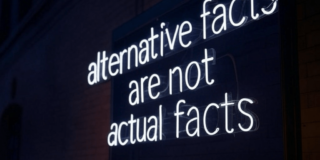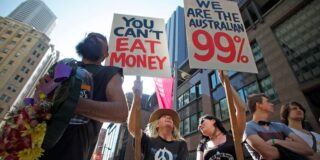“I’m not sure it’s the law that would do it [silence political dissent], it’s more the climate that does it.
I’ve been critical, openly critical of aspects of government policy and that’s had some consequences for me, I’m self employed and I’m at a stage of my career where I can withstand the consequences of saying unpopular things, but if I were employed somewhere, if I were at the stage of having a mortgage and school fees to pay, I think I’d probably be censoring myself, because most people don’t want to end up on the financial scrap heap just because they feel like speaking out about things that are wrong according to their view of the world.
Our self-censorship is a real risk and when you have a climate that discourages open debate, a climate where the mainstream tabloid commentators attack ferociously anyone who contradicts the government line. That’s a recipe for suppression of free expression generally and of course it’s not the laws that say you can’t say ‘x’ it’s the climate which makes it suicidal to say ‘x’.” (Melbourne QC Julian Burnside, interview with UTS Reportage)
“If I were employed somewhere, if I were at the stage of having a mortgage and school fees to pay, I think I’d probably be censoring myself, because most people don’t want to end up on the financial scrap heap just because they feel like speaking out about things that are wrong…” These are the very sentiments that have been expressed to me in varying ways, by large numbers of people, as I have been collecting statements in support of a proposed application to the United Nations Human Rights Committee (UNHRC).
In this current political environment of fear and reprisal that has informed the Australian collective since the Howard years, people of goodwill are being silenced through fear of fear itself.
Rising out of this fear of fear is: xenophobia, marginalisation, greed and hypocrisy. There can be no soft landing in this type of environment.
While Australia’s employed middle classes are enjoying the ‘good life’, while living in fear of losing it, other Australians are being marginalised, exploited, robbed and murdered – all in the name of that ‘good life’.
April 15th marks the twentieth anniversary of the release of the 339 recommendations and Final Report of the Royal Commission into Aboriginal Deaths in Custody. What has been achieved in the intervening twenty years? Nothing, absolutely nothing!
The following data all comes from The Australian Institute of Criminology’s Deaths in custody in Australia: National Deaths in Custody Program 2008, which contains the most recent data available regarding the ongoing issue of Aboriginal deaths in custody.
Indigenous people comprise less than 2.5 percent of the total Australian population, but account for over a quarter (28%) of young people in juvenile detention, one-third (33%) of people involved in police custody incidents and almost one-quarter (24%) of the total prison population.
When reporting statistics on Indigenous persons it is important to note, as with the criminal justice system more generally, Indigenous status is not always collected and when it is, the recording is not always consistent. Moreover, the way in which Indigenous status is determined varies between jurisdictions. The recording of Indigenous status may be based on a subjective judgement of physical appearance or may rely on self-reporting. Also of concern are numbers of people with unknown Indigenous status.
A recent study conducted in 2009 by Hunter & Ayyar of the Australian National University observed that the size of Indigenous involvement in the criminal justice system has be severely underestimated and will continue to be severely underestimated if no attempt is made to establish or estimate the true identity of the large number of people with unknown ATSI status.
What Hunter & Ayyar are actually saying is that the true extent and nature of Indigenous incarceration in Australia remains unknown, meaning that the statistics quoted above may be underestimating the true problem by a large margin!
What we do know as a minimum is that:
- Indigenous juveniles are 28 times more likely than non-Indigenous juveniles to be in detention.
- Indigenous persons were 22 times more likely than non-Indigenous persons to be arrested or detained by police and accounted for 33 percent of all police custody incidents across Australia in 2007.
- In the most recent prison census data, the ratio of imprisonment rates of Indigenous to non-Indigenous persons was 17:1; Indigenous people had an imprisonment rate 17 times higher than that of non-Indigenous persons.
- Between 1980 and 2008, there were 392 Aboriginal deaths in custody Australia wide. Again this figure is likely to underestimate the problem due to the issues raised by Hunter & Ayyar.
Studies also indicate that Indigenous people have disproportionately high rates of contact with the courts. For example, the rate of contact with the court system was almost 4.5 times higher for Indigenous persons than for the entire NSW population and Indigenous persons were 16 times more likely to be imprisoned than the wider NSW population.
Other realities of Indigenous Australian life
Indigenous people currently have a life expectancy at birth that is 17 years less than that of the wider Australian population and they experience higher rates of long-term health conditions such as asthma, diabetes and kidney failure.
We as a people are subjected to manipulation and cajolement that if we were white, would be considered criminal; because we’re black and the perpetrators white and include some of Australia’s richest people, it becomes acceptable to the fear ridden Australian middle classes.
In an article Australia leases out mineral-rich land as China’s hunger for resources grows, the UK’s Guardian newspaper reports that Mr. Clive Palmer, one of Australia’s richest men, has leased a huge area in Australia’s Pilbara to China’s Citic Pacific’s Sino Iron project. The project expects to extract 2 billion tonnes of high grade iron ore from its open cast mine in the area over the next 25 years.
In return Australia, already China’s biggest overseas supplier of iron ore, will receive some royalties and taxes, depending on what Prime Minister Gillard finally manages to negotiate with the mining industry by way of a Minerals Rent Tax.
The deal’s biggest winner will be Clive Palmer, who claims to control the mining rights to land which contains 160bn tonnes of iron ore – 100 times greater than the entire global output of iron ore last year.
What are the Aboriginal people of the Pilbara region, the rightful owners of the land and its resources, getting out of the deal? A few scraps in the form of royalties and a few lowly paid jobs, at best!
First, the regions wealth was hijacked by greedy white folk. Now it is being hijacked by a foreign multi-national, with the help of one greedy white man, to the ultimate detriment of all Australians. All the while, the middle class sit back and watch in a fear induced catatonic state.
Meanwhile, another Chinese-owned metals conglomerate, has plans to develop a massive opencast iron ore mine in the Weld range, a ridge of hills 400 miles north-east of Perth. Geologists believe it will yield up to 300m tons of high-grade iron ore over 20 years. But it is a sensitive project. The red-tinged rock is not just rich in iron oxide, it contains archaeological evidence from thousands of years of Aboriginal life.
Colin Hamlett, an elder of the Wajarri people, is leading a campaign to prevent Sinosteel digging up his ancestors’ sacred places. His great-grandmother was buried at a site designated as dump for mine tailings. Hamlett says:
“This land tells the story of my people, our songlines, our camps, our relics, they’re all here.”
Yet, all this means nothing when greed takes over, while the middle class sit back and watch in their fear induced catatonic state.
Is it any wonder Indigenous Australians record such appalling health, educational and criminal justice statistics? Wake up Australia, your greed is not only destroying our culture, it will ultimately destroy your way of life, which you are letting a few sell to their benefit and your ultimate detriment.



Pingback: Doubly damned: Mentally ill & Indigenous | Blak and Black